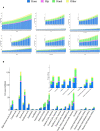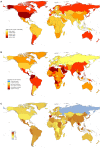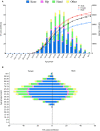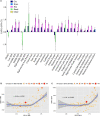Prevalence Trends of Site-Specific Osteoarthritis From 1990 to 2019: Findings From the Global Burden of Disease Study 2019
- PMID: 35233975
- PMCID: PMC9543105
- DOI: 10.1002/art.42089
Prevalence Trends of Site-Specific Osteoarthritis From 1990 to 2019: Findings From the Global Burden of Disease Study 2019
Abstract
Objective: To estimate systematic and anatomic site-specific age-standardized prevalence rates (ASRs) and analyze the secular trends of osteoarthritis (OA) at global, regional, and national levels.
Methods: Data were derived from the Global Burden of Disease Study 2019. ASRs and their estimated annual percentage changes (EAPCs) were used to describe the secular trends of OA according to age group, sex, region, country, and territory, as well as the joints involved.
Results: Globally, prevalent cases of OA increased by 113.25%, from 247.51 million in 1990 to 527.81 million in 2019. ASRs were 6,173.38 per 100,000 in 1990 and 6,348.25 per 100,000 in 2019, with an average annual increase of 0.12% (95% confidence interval [95% CI] 0.11%, 0.14%). The ASR of OA increased for the knee, hip, and other joints, but decreased for the hand, with EAPCs of 0.32 (95% CI 0.29, 0.34), 0.28 (95% CI 0.26, 0.31), 0.18 (95% CI 0.18, 0.19), and -0.36 (95% CI -0.38, -0.33), respectively. OA prevalence increased with age and revealed female preponderance, geographic diversity, and disparity with regard to anatomic site. OA of the knee contributed the most to the overall burden, while OA of the hip had the highest EAPC in most regions.
Conclusion: OA has remained a major public health concern worldwide over the past decades. The prevalence of OA has increased and diversified by geographic location and affected joint. Prevention and early treatment are pivotal to mitigating the growing burden of OA.
© 2022 The Authors. Arthritis & Rheumatology published by Wiley Periodicals LLC on behalf of American College of Rheumatology.
Figures





Comment in
-
Very limited data in the Global Burden of Disease Study 2019 to estimate the prevalence of osteoarthritis in 204 countries over 30 years: comment on the article by Long et al.Arthritis Rheumatol. 2022 Aug;74(8):1455-1456. doi: 10.1002/art.42136. Epub 2022 Jun 28. Arthritis Rheumatol. 2022. PMID: 35373923 No abstract available.
References
-
- Hunter DJ, Bierma‐Zeinstra S. Osteoarthritis. Lancet 2019;393:1745–59. - PubMed
-
- Global Burden of Disease Collaborative Network . Global Burden of Disease Study 2019 (GBD 2019) Results. Seattle, United States: Institute for Health Metrics and Evaluation (IHME), 2020. URL: http://ghdx.healthdata.org/gbd-results-tool.
-
- Osteoarthritis Research Society International . Osteoarthritis Research Society International white paper: OA as a serious disease. 2016. URL: https://oarsi.org/education/oarsi-resources/oarsi-white-paper-oa-serious....
Publication types
MeSH terms
LinkOut - more resources
Full Text Sources
Medical
Miscellaneous

